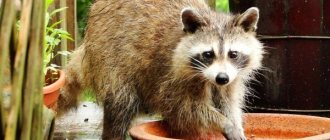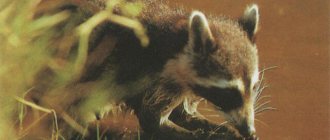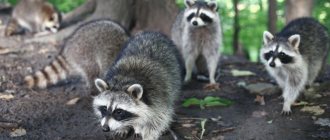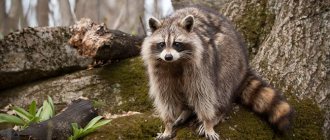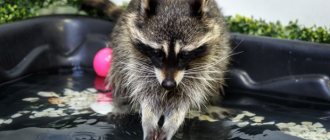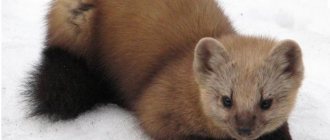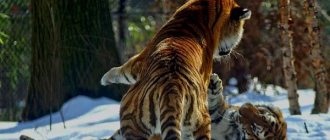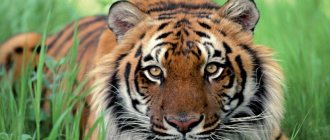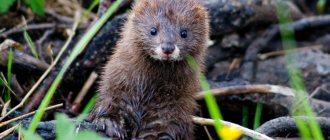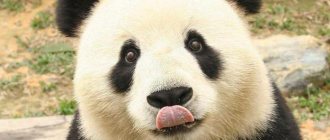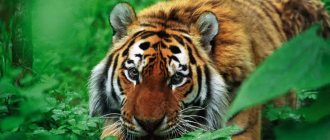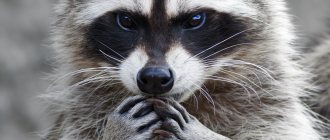These charming and interesting creatures are considered one of the most resilient in nature. The environment is very favorable to raccoons. As they say in North America, the homeland of the raccoon, raccoons are found where they can chew something edible.
Raccoons are nomadic by nature. Their location directly depends on food supplies, and can change depending on the year’s harvest. Also, raccoon habitats can be determined by soil fertility. Raccoons are always attracted to productive land.
general information
The raccoon (in Latin the name of the animal sounds like Procyon) is a predatory mammal of the raccoon family that lives in temperate and tropical climates. The appearance, gastronomic preferences and habitat of raccoons may differ slightly, because in nature there are 4 types of these animals:
- Raccoon;
- Raccoon-eater;
- Cozumel raccoon;
- Guadalupe raccoon.
Initially, the habitat of raccoons was limited to the corresponding regions of South and North America, but with human help, the animals successfully took root on the islands, as well as in many regions of Eurasia.
It is worth noting that on the territory of Russia you can only find representatives of the first species, since the habitat of the other 3 raccoons is too different from the climatic conditions of our country.
To understand where raccoons live, what they look like and what they eat, we suggest talking in more detail about each of the 4 species.
Habitat
The animals prefer to settle in the forest, mainly in mixed hollow forests, in close proximity to water bodies. Access to water is a prerequisite for a raccoon to live, be it a river, lake or even a swamp.
Raccoons are less common in foothill forests and steppes.
The raccoon’s ability to adapt to any climatic conditions is surprising, in the hot countries of Central Asia and in the extremely cold winters of the Russian Far East.
Raccoons are not afraid of humans, so they often inhabit suburbs, squares and the outskirts of city parks.
Places where you definitely cannot find representatives of the raccoon family are arid and coniferous forests. A raccoon cannot live without water, and the bright smell of pine needles repels the animal.
Raccoon (Procyon lotor)
The most common species, which has successfully taken root in the Ciscaucasia and Western Caucasus, walnut forests of Kyrgyzstan, as well as in Primorye. It is this species that most Russians associate with the name “raccoon”, and is also depicted in various pictures. Today the fluffy North American guest can be found not only in Russia, but also in many European countries.
Interesting fact! This raccoon received the name “rinse” for its peculiarity - to wash any food, be it delicacies caught in a pond, an insect caught on land or fruit. The need to “rinse” food is not a tribute to cleanliness, but an uncreated action, formed in the process of evolution and fixed at the level of reflexes.
We recognize the striped raccoon by its fluffy brown-gray coat with a characteristic striped pattern and a dark “mask” on its face.
The “gargle” is the size of an ordinary domestic cat or a medium-sized dog - the weight of an adult varies between 5-9 kg, and the body length can reach 60 cm (+ tail about 20-25 cm). Omnivorousness, the ability to perfectly adapt to different climatic conditions, as well as the lively mind and mobility of these babies contributed to a significant expansion of the raccoons’ habitat. Moreover, in many countries this particular species is kept as pets, because the “gargler” is highly tamed and can live in captivity for up to 20 years.
Important! The striped raccoon perfectly defends itself against larger predators, so if you encounter an animal in its natural habitat, it is better not to frighten or disturb it. Danger to humans can come not only from the sharp teeth of a small predator, but also from a fairly wide range of diseases, the carriers of which are often wild animals.
Reproduction and lifespan
The breeding season for raccoons begins in the northern regions with the beginning of spring, and in the southern regions it has no boundaries. Males are polygamous and search for females by smell. After mating, they go in search of their next partner.
Males live alone and do not take part in raising offspring. Female raccoons are associated with only one chosen one. The factor of animal relationships is important to consider in captivity.
The female bears the offspring for 63 days. For the future preservation of the brood, raccoons look for spare holes in advance so that in case of danger they can move with the babies. There may be more than a dozen such shelters. A separate hollow is prepared for the birth of babies. Before the birth of the offspring, the female becomes very aggressive.
After the birth of the cubs, the female has to look for food for herself and her children.
Newborn raccoons do not see, do not hear, and they have no teeth. The baby weighs approximately 75 grams. A litter contains from one to six cubs, covered with short, light brown hair. Distinctive rings on the tail and a stripe on the head appear after 10 days of life. The eyes open after 2-3 weeks.
The female feeds the babies with milk for up to 3 months. Feeding occurs on average 20 times per day. Raccoons scream and whistle shrilly. As they grow older, the sounds made become quieter, and gradually the raccoons switch to adult food.
The female takes care of the offspring for up to 5 months, then the babies begin to live independently. In winter, some individuals remain near their mother. The cold period is a severe test for young animals. The surviving raccoons can be considered hardened for natural living conditions.
Young females become sexually mature after a year, males - by two years of age. In the natural environment, the life of cute animals lasts from 2 to 5 years. How long a striped raccoon lives in captivity depends on the conditions of detention and proper feeding. Life expectancy is 14 - 20 years.
Raccoon-eater (Procyon cancrivorus)
A species of raccoon whose habitat is exclusively in the jungles and swamps of South and Central America.
Unlike its relative, which has successfully established itself in Russia, Procyon cancrivorus has a more streamlined body. Its fur is shorter and fits more tightly to the body, which is why the animal appears thinner. The color is standard, with a classic “mask” on the face and a striped tail.
The name “crawfish eater” was given due to its preferences - the animal loves to feast on seafood, although in the absence of seafood it easily feeds on any available food, hunting insects and small rodents, collecting berries and plant rhizomes, and also destroying bird nests.
Types of raccoons
Scientists spent quite a long time deciding what type of animal to classify raccoons as. His image combines the gait of a bear and an external affinity with dogs and cats. The fur of the animal was called “Genette” for its similar color. For its unusual habits associated with washing food before eating, the raccoon animal is nicknamed “gargle”. As a result, we had to separate these animals into a separate family.
There are only 4 species, two of which are endemic - Cozumel and Guadalupe. The American raccoon, or striper, is the most common, and the crayfish lives exclusively in the jungle.
Cozumel raccoon (Procyon pygmaeus)
Finding out where the rare Cozumel raccoons live in the wild is not difficult, because the species received its unusual name from the Mexican island of Cozumel, located in the Caribbean Sea.
Interesting! It is an endemic species found only in the mangrove forests of the island, which covers an area of 475 km2.
Procyon pygmaeus looks different from its North American relatives. It is much smaller than the stripers (as a rule, their weight does not exceed 4 kg).
Most of the diet of Cozumel raccoons consists of crustaceans and amphibians, although, if possible, the animals do not mind eating the fruits of tropical Manilcara or even millet growing on the island.
Nutrition
The main search for food among raccoons is usually concentrated around water sources. They can catch fish, arthropods, frogs and some species of turtles.
Raccoons also love turtle eggs, hamsters, muskrats and musk rats. When hunting in the forest, the animal feeds mainly on insects, larvae, earthworms, fruits, berries, nuts and bird eggs.
Some regions suffer some damage due to the fact that raccoons regularly raid chicken coops and industrial poultry farming areas.
Raccoons, being predators, are not averse to eating rabbits, snails and squirrels. However, their diet also includes numerous berries, cherries, gooseberries, grapes, vegetables, grains and much more.
Guadalupe raccoon (Procyon minor)
It is not difficult to understand where Guadalupe raccoons live, because these animals got their name precisely from their habitat - the department of the same name in France on the islands of the Caribbean.
Visually, the raccoons living in Guadeloupe are very similar to their North American relatives, so many scientists believe that the islands are not inhabited by a separate species, but simply a striped raccoon adapted to island life. However, today Procyon minor is classified as a separate species due to the presence of a number of significant differences in anatomy and biology.
Important! The Guadalupe raccoon is considered an endangered species, because its habitat does not allow for the development of new territories, and the inhabitants of the islands actively hunted these animals because of their beautiful fur and meat, which is widely used in local cuisine.
Wild Lifestyle
Finding a raccoon during the day is almost impossible due to its nocturnal lifestyle. During the day, the animals sleep, and at nightfall they go out hunting. It is noteworthy that the raccoon does not build its own home, but occupies someone else’s, giving preference to tree hollows, and strives to climb higher and into a more spacious hollow. By the characteristic scratches on the tree bark, you can understand that a raccoon’s home is located at the top. If the area is not rich in hollow trees, the raccoon will live in other people's holes, often driving out the previous residents. The animals live in small flocks, but in the cold season up to ten individuals can live in one hole. Living in populated areas, raccoons settle in abandoned buildings, in the attics of residential buildings, in old cars and garbage containers, causing a lot of trouble for people. By their nature, raccoons are not conflict-oriented, preferring to solve problems by running away. However, in the event of an attack, they are able to fight back the offender. Behind the cute little face lies a very dangerous predator, with sharp fangs, nails, remarkable physical strength and ingenuity.
Water plays a special role in the life of a raccoon.
Raccoons spend most of their lives near water, hunting, catching fish and crayfish. A calculating and very intelligent predator, the raccoon always drowns its prey in water before eating it. Because of its love for water, the animal received the name striped raccoon. In addition, water allows you to cleanse sensitive paws, making them more receptive. By nature, raccoons are nomads, changing their habitat throughout their lives as their food reserves become depleted. Animals are attracted to productive lands, where there is always something to eat, because raccoons are omnivores and love to feast on vegetables, fruits, nuts and berries. Raccoons prefer to eat plant foods in spring and summer. In the fall, the diet is replaced by animal food in order to stock up on fat and prepare for hibernation. Raccoons do not hesitate to rummage through trash cans, beg people for food, or simply steal it by sneaking into the house. Private farms - chicken coops, fruit and vegetable plantings, wineries - suffer from raccoon raids.
How to keep raccoons at home
Keeping a wild animal at home has certain difficulties. This animal is very active and curious. He can easily open any door or unscrew a faucet.
Therefore, he must always be supervised. During the absence of the owner and at night, he must be locked in a cage . For games, he needs to make an extensive special enclosure.
You need to make sure that your restless pet always has something to do. He also needs free access to fresh water . The water container must be sufficiently stable. The animal can turn it over very easily.
Raccoons in the forests love to climb trees. Therefore, the house must also have a structure for this purpose.
It is very easy to tame an animal, but it is better to take a small animal into your home. An adult animal will take much longer to get used to its owner. With the onset of puberty, a raccoon may become aggressive and less sociable. Therefore, scientists do not recommend keeping the animal with other pets.
Pros and cons of content
Before you decide to keep a pet at home like a striped raccoon, you should study reviews about it.
You can only get this animal if you are sure that you will find enough time and money to maintain and raise it. The domestic striped raccoon requires more attention than a cat or dog. If your work involves constant travel, you should not get a gargle dog, because the animal is completely dependent on you: it needs not only food and a clean home, but also care and attention. Without receiving it, the animal becomes aggressive and uncontrollable.
It is also not worth getting a raccoon for a child: the animal is large and dangerous. During games, he can scratch the child, even if you spent a lot of time raising the animal before. The point is the sharp claws of raccoons, which they cannot retract. In addition, they do not understand who is in front of them: an adult or a child.
However, if you sincerely love these animals and are ready to endure all their antics, communication with raccoons will bring you only advantages. With proper upbringing, these animals become affectionate, playful and kind, and any contact with them brings joy and satisfaction.
Results of acclimatization in different regions
As for whether raccoons live in Russia in those territories where conditions are quite extreme, it should be noted that these creatures are quite adapted to this. The massive resettlement of raccoons made it possible to prove that animals are able to survive in areas that differ greatly in climate. Raccoons take root even where winters are quite long and harsh.
Particularly large populations of raccoons have formed in the flat areas and in the foothills of the North Caucasus. In the new conditions, raccoons have perfectly mastered not only open but also closed landscapes, with deciduous, coniferous or mixed forests. Raccoons can be observed not only in steppe and forest-steppe zones, but also in semi-deserts.
In such areas of Russia as the Kola Peninsula, the Arkhangelsk region and the Komi Republic, the resettlement of raccoons was not particularly successful. They disappeared almost completely from these areas, and if they remained somewhere, their populations are still not particularly large.
